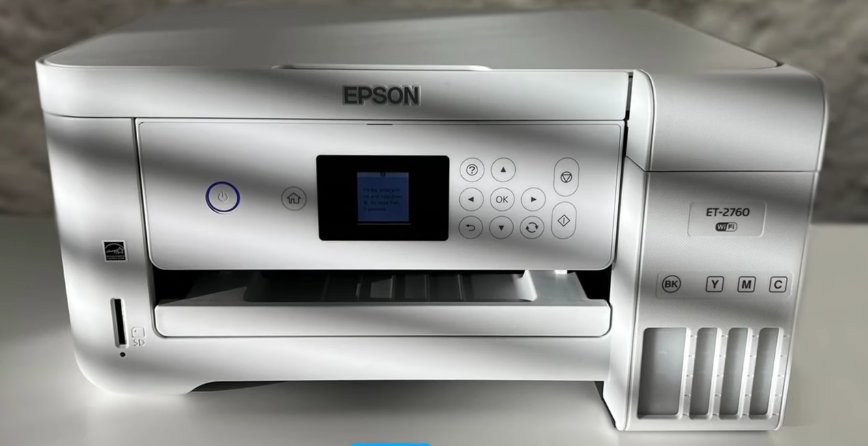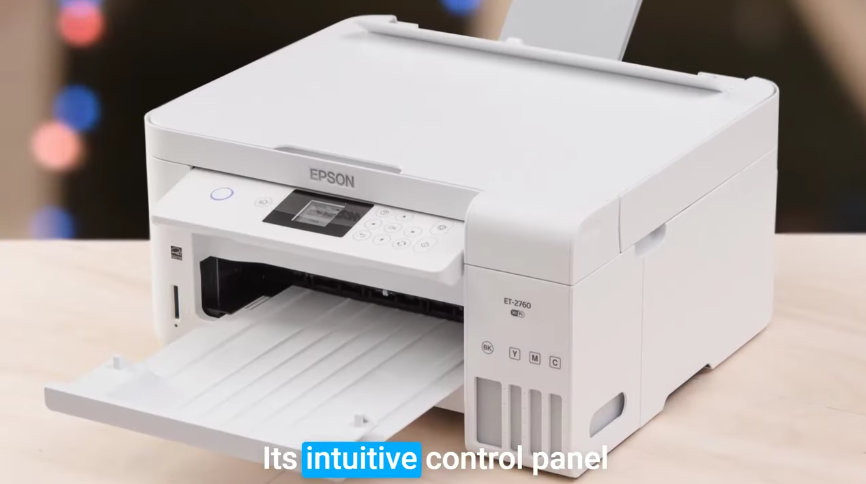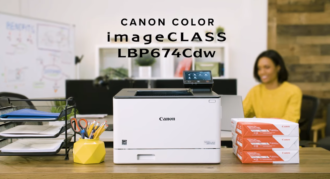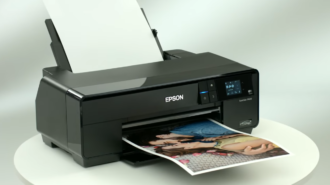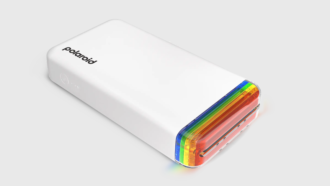Epson EcoTank ET: Review
Most inkjet printers can print Christmas photos on coated paper, but professional photographers need more. The Epson EcoTank ET-18100 is a picture printer that supports A3+ (329x483mm) paper and uses a six-ink print engine to reproduce colours with more subtlety and less grain. Despite its six-ink printhead and six huge ink tanks, the EcoTank ET-18100 is remarkably small for an inkjet printer that handles A3 and A3+ paper. Despite its square appearance, it’s clever enough when the printer’s enormous input and output trays are fully extended. Photo printing is thirsty, so having bottles of ink instead of cartridges might be a big plus. See my complete review.
Epson EcoTank ET Specs
| Printing Method | On-demand Inkjet (piezoelectric) |
| Minimum Ink Droplet Volume | 1.5 Picolitres |
| Print Resolution | 5760 x 1440 dpi |
| Max Photo Default | Approx. 15 sec per photo |
| Double Sided Printing | Yes |
| Scanner Type | A4 Flatbed colour image scanner |
| Document Size | Up to A4 |
| Resolution | 1200 x 4800 dpi |
| OS | Windows x64 |
Design and features
Epson EcoTank ET-18100 controls and functionality are limited. This is a single-function printer with no scanning or copying. There is no display; there are simply buttons and indicator lights on the front left. This printer can print normal paper, but it prefers images. It lacks automatic duplex, which is essential for an office printer at this price. With over a decade of developing EcoTank printers, Epson has fixed any issues. It’s simple to open a bottle, invert it over the tank, and let the ink pour in. The new design’s bottles have unique keys to prevent pricey ‘wrong colour’ mistakes, so I’ve never spilled a drop.
Open-topped six-ink tanks
This printer has bottled ink for 7,200 plain A4 pages of mixed text and images. Despite a one-time priming procedure, Epson claims 1,500 10x15cm (6×4”) postcard-sized prints from the ink in the box, which is more than any cartridge-based equivalent. This printer runs at 3.3p per postcard print, with £12 per colour ink that should last 2,100 prints. It costs around $6 per A4 page to store it on protected picture paper. This leaves the elephant in the room. The price of this printer is approximately £600, making it twice as expensive as a comparable-priced cartridge-based inkjet. Bottled ink costs more than cartridges because printer makers make less profit.
Print quality and speed
Note that the EcoTank ET-1810 is a simpler A4 printer, which is confusing. The Epson EcoTank ET-18100 doesn’t come with a driver disc, and the first Google search for “ET-18100 drivers” directed you to ET-1810 drivers at the time of my review. Despite this drawback, this printer is easy to set up and operate. It will cheerfully do ordinary paper tasks, but don’t anticipate outstanding results. Dye-based inks work well on coated picture sheets but not on plain paper, like pigment inks on office devices. Thus, lettering isn’t black, and visuals’ hues lack urgency and intensity. Our regular plain paper testing showed the printer producing black text at 5.7 ppm. It ran colour graphics at 5.5 ppm on our five-page test.
This printer is for photos, and it’s much better at high print quality. I printed with and without borders on Epson’s 10x15cm, A4, and A3+ sheets and got wonderful results. In the lightest portions of my test prints, where ink dots would be most likely to occur, I could hardly see them using a magnifying lens. The photos seemed lab-made to the naked eye.
However, these weren’t my favourite photos. I’ve preferred Epson prints over Canon ones since they have warmer, more realistic colours but less clarity. It felt opposite here.
What about shots?
The ET-18100 overexposed bright colours in numerous images, washing away clouds, light skin, and sun-baked wood. The Epson (right) and Canon’s eight-colour PIXMA PRO-200 are compared below. Note my son’s skin’s relative lack of detail. Although photo quality is subjective, the Epson EcoTank ET-18100 performed well in other printing. I liked its sunrise shot of a silver automobile near a loch because its slightly cold tone highlighted the car against the sky’s warmth.
My black-and-white test shot had a small green bias, but I liked its clarity and detail. Unfortunately, picture comparisons didn’t reveal either change, illustrating how tiny the difference is. Photos may be printed quickly with this printer. It produced six borderless 10x15cm prints in under eight minutes and one A4 print in under three and a half. Printing a borderless A3+ took six and a half minutes.
How to Setup Epson EcoTank ET
- On the Epson support main page, choose your product, then Manuals to see the Start Here sheet.
- Epson Connect Printer Setup Utility download and installation
- Accept the End-User License Agreement, then click Next.
- Click Finish after installing.
- Select Printer Registration, then Next.
- Click OK on the Register a printer to Epson Connect dialogue.
- Complete the Create an Epson Connect Account form and click Finish to create a new account.
- Select I already have an account; fill out the Add a new printer form, then click Add to register a new product with an existing account.
- Select Close.
- Activate Scan to Cloud and Remote Print using our instructions.
Should you buy?
You print plenty of images and want a good price-quality ratio. Epson Eco-Tank ET-18100 printers prioritise numbers above quality. It’s designed for amateur photographers’ picture prints. Avoid if quality matters more than photo prints. Epson EcoTank ET-18100 isn’t for those who want exceptional plain paper performance or professional-quality photographs.
| PROS | CONS |
| Excellent printing. | Unautomated document feeder |
| Very cheap running expenses. | Not Ethernet-connected |
| Light and little | |
| SD-compatible | |
| Features automated two-sided printing |
One last thought
The Epson EcoTank ET-18100 is pricey, but it may save you money if you print many images. I doubt pro photographers would be satisfied with my test prints, but they were better than four-colour inkjet prints. They’re not up to par for limited prints or folios. Given that, this printer may be best for enthusiastic amateurs who plan to print a lot. Its quality and cost savings over cartridge inkjet printers or lab prints would undoubtedly please them. Consider Canon’s PIXMA Pro-200 for image quality.


